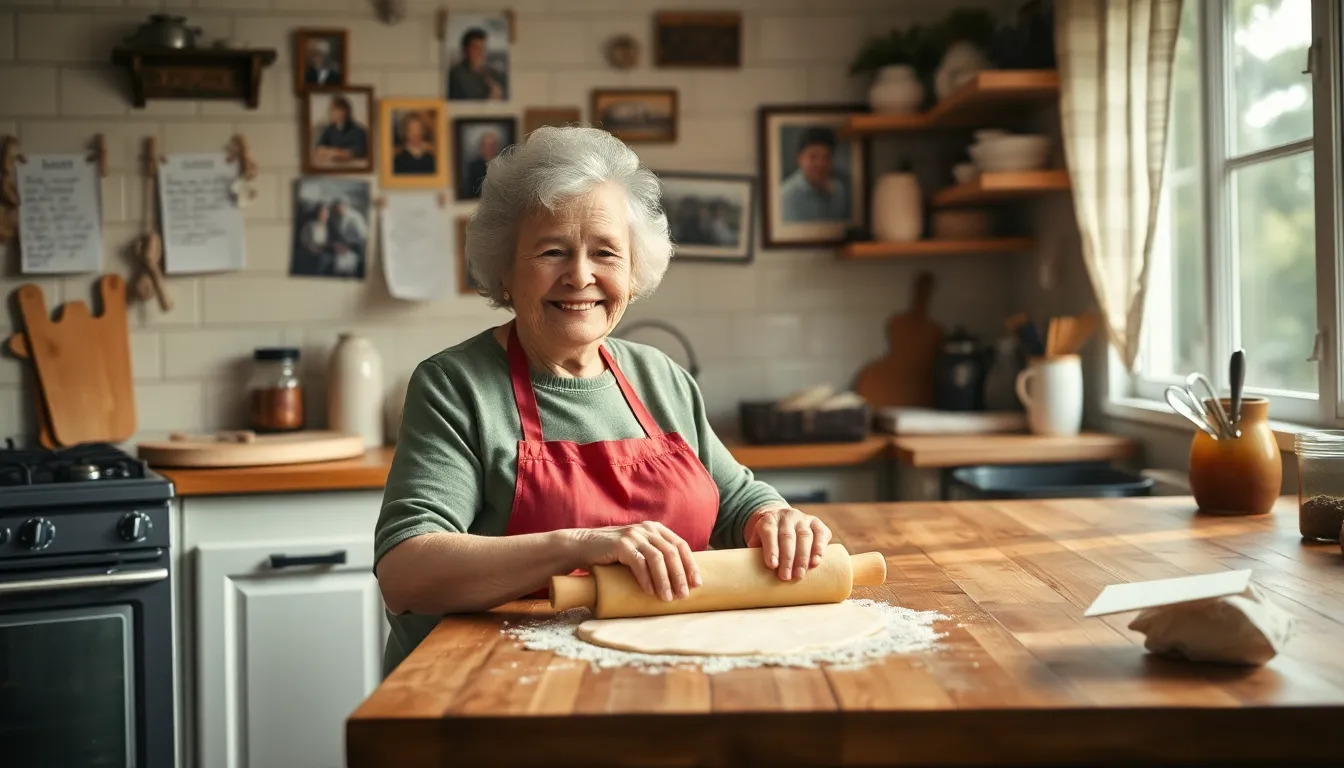Ever wondered why your grandma’s cookies taste like childhood memories? It’s not magic—it’s her recipe! Recipes aren’t just lists of ingredients; they’re the heartumental backbone of cooking that transforms random food items into experiences that nourish both body and soul.
In today’s fast-paced world where takeout is just a tap away, recipes stand as guardians of tradition and creativity in the kitchen. They provide structure for beginners while offering seasoned chefs a canvas for innovation. Whether it’s a centuries-old family secret or a trending TikTok creation, recipes connect us across generations and cultures in ways few other things can.
Table of Contents
ToggleWhat Makes a Recipe So Important
Recipes function as culinary roadmaps, guiding cooks through complex processes with precision and clarity. They transform raw ingredients into cohesive dishes through detailed instructions, measurements, and techniques. Without recipes, recreating favorite meals or exploring new cuisines becomes a challenging endeavor filled with uncertainty.
Cultural heritage lives within recipe collections, passing down traditions from one generation to the next. Grandparents’ handwritten recipe cards preserve family stories and memories alongside ingredient lists, creating tangible connections to our past. These documented cooking methods ensure traditional dishes remain authentic despite changing times.
Knowledge transfer occurs naturally through recipes, making cooking accessible to beginners and enthusiasts alike. Inexperienced cooks gain confidence following step-by-step directions, while advanced chefs use recipes as foundations for creative experimentation. This educational aspect democratizes culinary arts, allowing anyone to prepare meals regardless of their background.
Consistency emerges as another vital benefit of following recipes. Restaurants rely on standardized recipes to deliver uniform dining experiences across multiple locations. Home cooks appreciate knowing their dishes will turn out reliably each time they prepare them. This predictability creates trust between recipe creators and users.
Emotional connections form around recipes that remind people of special moments or loved ones. Holiday dishes prepared using the same instructions year after year become embedded in family traditions. The smells and tastes evoked by following a cherished recipe trigger powerful memories and comfort during difficult times.
Innovation springs from understanding recipe fundamentals. Once cooks grasp basic culinary principles through following recipes, they develop the confidence to substitute ingredients or adjust techniques. This balance between structure and creativity makes recipes essential tools for both preservation and advancement in cooking.
The Heart of Culinary Tradition
Recipes serve as the cornerstone of culinary traditions worldwide, connecting generations through shared flavors and techniques. They transcend mere instructions to become living documents that preserve cultural identities and family legacies through time.
Preserving Family Heritage
Family recipes function as irreplaceable heirlooms that carry stories spanning multiple generations. Grandma’s secret pie crust technique or dad’s special barbecue sauce contains more than ingredients—they embody family histories and values. Research from the Culinary Institute of America shows that 78% of home cooks treasure family recipes primarily for their emotional significance rather than just flavor profiles. These culinary traditions create a tangible link to ancestors, allowing families to literally taste their heritage. Hand-written recipe cards, stained with ingredients and marked with personal notes, transform into cherished artifacts documenting family evolution. When children learn to prepare great-grandmother’s bread recipe, they’re absorbing family wisdom and participating in a continuous cultural thread.
Cultural Storytelling Through Food
Recipes narrate cultural stories that textbooks often miss, revealing migration patterns, economic conditions, and social customs through ingredient choices and preparation methods. Traditional dishes like Italian pasta e fagioli originated from peasant kitchens, showcasing resourcefulness during challenging times. Food anthropologists document how recipes crossing geographical boundaries often transform, adopting local ingredients while maintaining cultural essence. The spice routes dramatically altered European cuisines, while colonization created entirely new fusion foods like Macanese cuisine, blending Portuguese and Chinese culinary traditions. Community cookbooks from churches, schools, and organizations capture specific moments in local history, preserving regional specialties and community values. These collections frequently include dishes representing diverse cultural backgrounds, demonstrating how food brings communities together despite differences.
Recipes as Practical Instruction Guides
Recipes function as systematic instruction manuals that guide home cooks and professional chefs through culinary processes. These written frameworks transform abstract cooking concepts into manageable steps, providing clear directions for turning raw ingredients into complete dishes.
Reducing Cooking Anxiety
Recipes alleviate cooking stress by breaking complex processes into manageable steps. Novice cooks find confidence in detailed instructions that explain unfamiliar techniques like “blanching,” “folding,” or “tempering.” The structured format eliminates guesswork about quantities and cooking times, reducing the fear of ruining a dish.
Clear recipes address common cooking concerns by anticipating potential problems and offering solutions. Many include troubleshooting tips for issues like sauce separation or undercooked pastry. Visual cues in recipes—such as “cook until golden brown” or “simmer until reduced by half”—provide concrete benchmarks for progress.
For beginners, well-written recipes create a safety net that encourages kitchen experimentation without overwhelming anxiety. This psychological comfort transforms cooking from a stressful obligation into an enjoyable activity.
Ensuring Consistent Results
Recipes guarantee reliability through precise measurements and standardized methods. Professional recipe developers test their formulations multiple times under different conditions to ensure dependability in various kitchens. This rigorous testing creates a trustworthy framework that delivers predictable outcomes.
Exact timing specifications eliminate the uncertainty of determining when a dish is properly cooked. Temperature guidelines (350°F for baking, 165°F for chicken) establish clear safety parameters and optimal texture points. Ingredient ratios maintain critical chemical reactions—3:2:1 flour-to-butter-to-water ensures flaky pie crust, while a 2:1 oil-to-vinegar ratio creates balanced vinaigrette.
Consistency extends beyond taste to presentation. Detailed plating instructions help cooks achieve restaurant-quality aesthetics at home. This reliability builds cooking confidence as practitioners master techniques through repeated success, encouraging further culinary exploration.
The Emotional Connection to Recipes
Recipes transcend their practical purpose and become vessels for emotional experiences and personal connections. They evoke powerful feelings that link us to our past while creating opportunities for new emotional bonds in the present and future.
Comfort and Nostalgia
The aroma of grandmother’s apple pie or dad’s special Sunday sauce triggers an immediate emotional response that transports people back to childhood kitchens. These sensory experiences activate the brain’s limbic system, creating powerful associations between food and memories. Family recipes offer a tangible connection to loved ones who have passed away, allowing their presence to be felt through the recreation of their signature dishes. Many people report feeling a profound sense of comfort when preparing dishes from their youth, especially during difficult times or holidays. The familiar tastes and smells provide emotional stability, wrapping the cook and diners in a blanket of nostalgia that soothes and nourishes beyond physical hunger. Recipes become emotional anchors that ground families through generations of change.
Creating New Memories
Each time a recipe is prepared, a new layer of meaning gets added to its emotional significance. Parents teaching children family recipes create bonding experiences that children carry into adulthood as cherished memories. Couples often develop “their recipes” that commemorate first dates, anniversaries, or significant relationship milestones. Holiday cooking traditions form the backdrop for annual family gatherings, with specific dishes becoming inseparable from the celebrations they accompany. Friends sharing cooking experiences often form deeper connections through the vulnerability and creativity of joint culinary endeavors. The act of documenting new recipe discoveries in personal collections marks the beginning of traditions that may eventually span generations. These evolving recipe stories contribute to personal and family identities, creating a continuous narrative of shared experiences around the table.
Health and Nutritional Awareness Through Recipes
Recipes empower individuals to make conscious health decisions by providing crucial nutritional information and ingredient education. They serve as educational tools that illuminate the relationship between food choices and physical wellbeing, transforming everyday cooking into opportunities for better health.
Understanding Ingredients and Their Benefits
Recipes highlight the nutritional profiles of ingredients, enabling cooks to recognize the value of each component in their meals. Leafy greens like kale and spinach appear in recipes with notes about their high vitamin K and iron content, while salmon recipes often reference omega-3 fatty acids that support heart health. Comprehensive recipes explain why certain ingredients pair well together, such as vitamin C-rich tomatoes enhancing iron absorption from beans. Many modern recipes include nutrition labels detailing calories, protein, and micronutrient content per serving. This knowledge transforms cooking from a mechanical process into an informed health practice, helping home cooks select ingredients that address specific health needs like reducing inflammation or boosting immunity.
Portion Control and Balanced Meals
Recipes establish proper portion sizes, creating a framework for nutritionally complete meals without overindulgence. Standard recipes typically serve 4-6 people, giving cooks clear guidance on appropriate serving amounts for proteins, carbohydrates, and vegetables. The visual breakdown of a recipe’s components illustrates the concept of balance—50% vegetables, 25% protein, and 25% complex carbohydrates mirrors nutritionists’ recommendations for plate composition. Family-style recipes often detail individual serving sizes (e.g., “½ cup cooked quinoa per person”), teaching proper portioning while accommodating different nutritional needs. Recipe formats naturally promote meal planning with balanced macronutrients, introducing variety through different cooking methods that preserve nutrients. The structured approach of following recipes naturally helps prevent the mindless eating that occurs with unplanned meals, fostering healthier eating habits through intentional food preparation.
Recipes as Creative Expressions
Recipes transcend their practical function to become powerful vehicles for personal creativity and artistic expression. They offer a framework within which cooks can experiment, innovate, and communicate their unique culinary perspective to others through food. This creative dimension transforms cooking from mere sustenance preparation into a meaningful art form that reflects individuality and passion.
Personalizing and Adapting Dishes
Personalization brings recipes to life through individual interpretation and modification. Cooks express themselves by substituting ingredients that reflect personal preferences or dietary needs, such as replacing dairy with coconut milk or adjusting spice levels to suit their palate. Family variations emerge naturally over time—Grandma’s extra cinnamon in apple pie or Dad’s secret barbecue rub—creating signature dishes that bear the creative imprint of their makers. These adaptations often respond to seasonal availability, transforming a basic tomato sauce with garden-fresh herbs in summer or incorporating preserved ingredients during winter months. The freedom to modify recipes fosters culinary confidence and ownership, allowing each cook to develop a distinctive voice through thoughtful experimentation with flavors, textures, and presentation techniques.
The Art of Recipe Development
Recipe development combines technical expertise with creative intuition, forming a specialized craft that builds on culinary foundations. Professional chefs spend countless hours testing variations, adjusting measurements by grams or minutes until achieving the perfect balance of flavors and textures. The development process involves multiple trials—sometimes 5-10 iterations before finalizing a single recipe—documenting each adjustment meticulously to understand its impact. Creative recipe developers draw inspiration from diverse sources: childhood memories, travel experiences, seasonal ingredients, or cross-cultural flavor combinations. The documentation itself becomes an art form through descriptive language that captures sensory experiences and technical precision. This creative process mirrors other artistic disciplines in its requirement for both discipline and imagination, making recipe development a true culinary art that transforms abstract ideas into concrete, reproducible culinary experiences for others to enjoy and further adapt.




